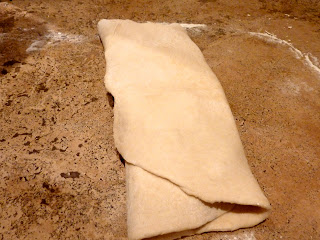Seven storms in seven weeks.
Many people, when faced with an impending storm, rush out to stock up on non-perishables. With an always-full pantry and freezer, I only think, "What can I bake?"
Kouign Amann has been on my radar since The Portland Pastry Chef sent me a link a year ago. Pronounced queen ya-mahn, this Breton pastry is a cross between a croissant, palmier and monkey bread, with buttery and sugary layers of yeasty dough. Yesterday, one of my favorite bloggers, David Lebovitz, posted on it, and I am finally succumbing to the siren call of this decadent treat. This is a first, and it surely won't be the last.
A snowy day with tantalizing yeasty, buttery smells— life doesn't get better than this!
 |
| The golden, crispy, chewy, caramelized bits are heavenly. |
Kouign Amann
from David Lebovitz's website
Printable Recipe
About 8 to 10 servings
1 tablespoon (12 g) dried yeast, not instant
¾ cup (175 ml) tepid water
2 cups (260 g) all-purpose flour
½ teaspoon sea salt
1 cup ( 200 g) sugar (which will be divided later)
Additional sugar for rolling out the pastry
1 stick salted butter (110 g), cut into ½-inch (2 cm) pieces and chilled, preferably salted European style butter, which has a higher butterfat content
2-3 tablespoons additional salted butter, melted
In a medium bowl, dissolve the yeast in the water with a pinch of sugar. Stir briefly, then let stand for 10 minutes until foamy.
Gradually stir the flour and salt. The dough should be soft, but not too sticky. Lightly dust your countertop with flour and transfer the dough onto it.
Knead the dough with your hands until the dough is smooth and elastic, about 3 minutes. If the dough is very sticky, knead in just enough flour, one tablespoon at a time, until the dough doesn’t stick to your hands.
Brush a medium bowl with melted butter, put the dough ball into the bowl. Cover, and let rest in a warm place for 1 hour.
Meanwhile, line a dinner plate with plastic wrap and set aside.
On a lightly floured countertop, roll the dough into a rectangle about 12″ x 18″ with the shorter sides to your left and right.
The dough may be sticky and difficult to handle. Use a metal pastry scraper to coax the dough into shape, and a minimal sprinkling of flour, as necessary.
Distribute the butter in the center of the dough and sprinkle with ¼ cup of sugar. If using unsalted butter, sprinkle a bit of fleur de sel over the butter/sugar.
Grab the left side of the dough, lift and fold it over the center, than do the same with the right side (like a letter).
You should have what resembles a 3-level pastry.
Sprinkle the entire length of the dough with ¼ cup of sugar and (without rolling) fold again into thirds, as before. Place on the plastic wrap-covered dinner plate and chill for 1 hour.
(At this point, wipe excess flour from the countertop and dust the countertop with a rather liberal handful of sugar for rolling out the pastry again.) Once chilled, remove dough from refrigerator. Ease it away from the plastic onto the sugar-covered countertop.
Top the dough with ¼ cup of sugar, press it in a bit with your hands, and roll into a rectangle for the the last time. Again, fold into thirds and let rest in the refrigerator for 60 minutes or overnight. Preheat oven to 425ºF and brush a 9-inch pie plate, preferably non-stick, with melted butter. I used a glass pie plate which worked fine.
Remove dough from refrigerator. Roll dough into a circle about the size of the baking pan. It will be sticky; dusting the top with a sprinkle of sugar will help. Once rolled, life the dough and coax it into the pan. (It will want to break. If so, fold it in half and quickly slide something flat under it, like the metal bench scrape AND a metal spatula and quickly slip it into the pan. If it does break, just piece it back together in the pan.)
Sprinkle with the remaining ¼ cup of sugar and drizzle with 1 tablespoon melted butter. I sprinkled some fleur de sel on top too.
Bake for 40-45 minutes, until the top is deeply caramelized. Let stand a few minutes, then run a spatula around the edges to release the pastry and slide the cake from the pan onto a cooling rack.
n.b. This first try, though delicious, was on the bready side. Maybe the dough was overworked and too dry—it will take some practice, and then more practice. I'm going to try the Oregonian one next!















I'm extremely impressed! It looks beautiful! I, myself, am still yeast-challenged!
ReplyDeleteOkay this looks seriously delicious. I may have to make this after my migraine subsides and allows me to crawl out of bed.
ReplyDeleteI keep re-reading the recipe and it reminds me of a quick-puff recipe and a short-cake recipe rolled into one. I think after I try the "original" recipe I may alter it with those two techniques in mind.
ReplyDeleteSG- wish we could spend a day together making pastry! it's so much fun.
ReplyDeleteJaleh- hope you feel better- tell me how it works out for you.
Rene- pls feel free to share your thoughts here about the recipe and how you would alter!
I used to eat amazing Kouign Amann when I lived in Japan and I miss them, thanks for posting the recipe!
ReplyDeleteI tried the DL recipe and yielded a chewy dough. I don't think his technique allows the butter to be distributed "evenly" to get the flakiness I was expecting. My tasters liked the pastry, but I wasn't satisfied. I will attempt another one of the other recipes and see how that fares.
ReplyDelete